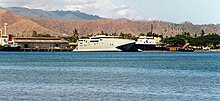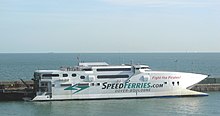HMAS Jervis Bay (AKR 45)
After an increase in instability in nations near Australia, the Australian Defence Force sought to upgrade a second brigade-size group to activation on short notice.
[3] Delays in refitting the two Kanimbla class vessels acquired from the United States Navy several years earlier meant that the RAN's sealift capability had to be supplemented in order to support two brigades.
[3] A two-year bareboat charter was signed for Incat 045 in May 1999, and the vessel was commissioned into the RAN as HMAS Jervis Bay on 10 June 1999.
[2][3] For military service, the catamaran was modified with enlarged fuel tanks to extend her range to 1,000 nautical miles (1,900 km; 1,200 mi) and additional air conditioning units to improve equipment operational reliability in tropical climates.
[3] Based in Darwin after commissioning, Jervis Bay was in a fortuitous position to respond to the 1999 East Timorese crisis, and was used to provide logistic support to the Australian-led INTERFET peacekeeping taskforce.
[3][4] Jervis Bay was then used to transport soldiers and equipment between Darwin and Dili: she was capable of sailing the 430 nautical miles (800 km; 490 mi) in around 11 hours[5] at an average speed of approximately 45 knots (83 km/h; 52 mph).
[6][7] Running the catamaran was found to be more efficient than using air transport to move materiel to and from East Timor, with the higher sailing speed meaning she could turn around a payload faster than multiple C-130 Hercules flights for an equivalent load.


